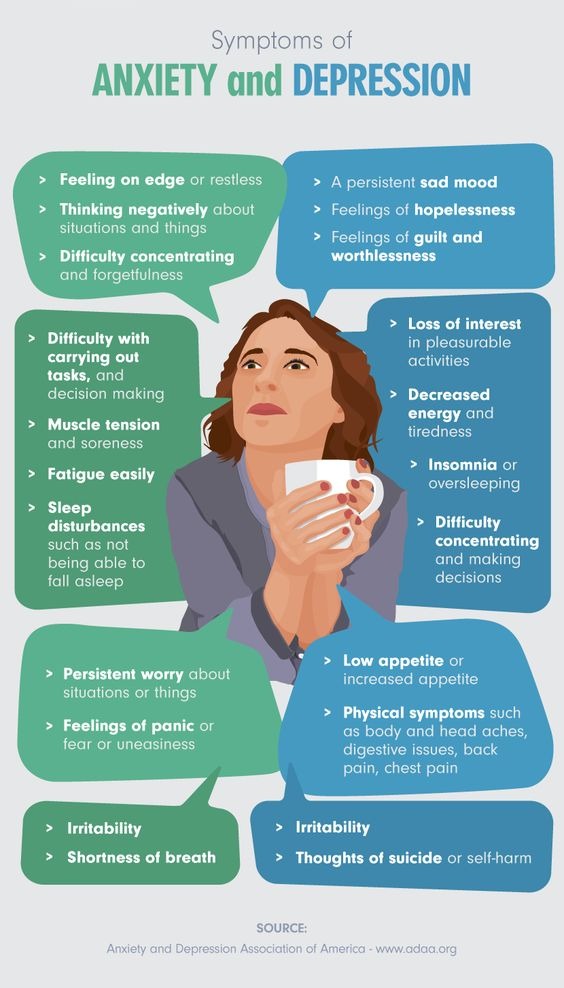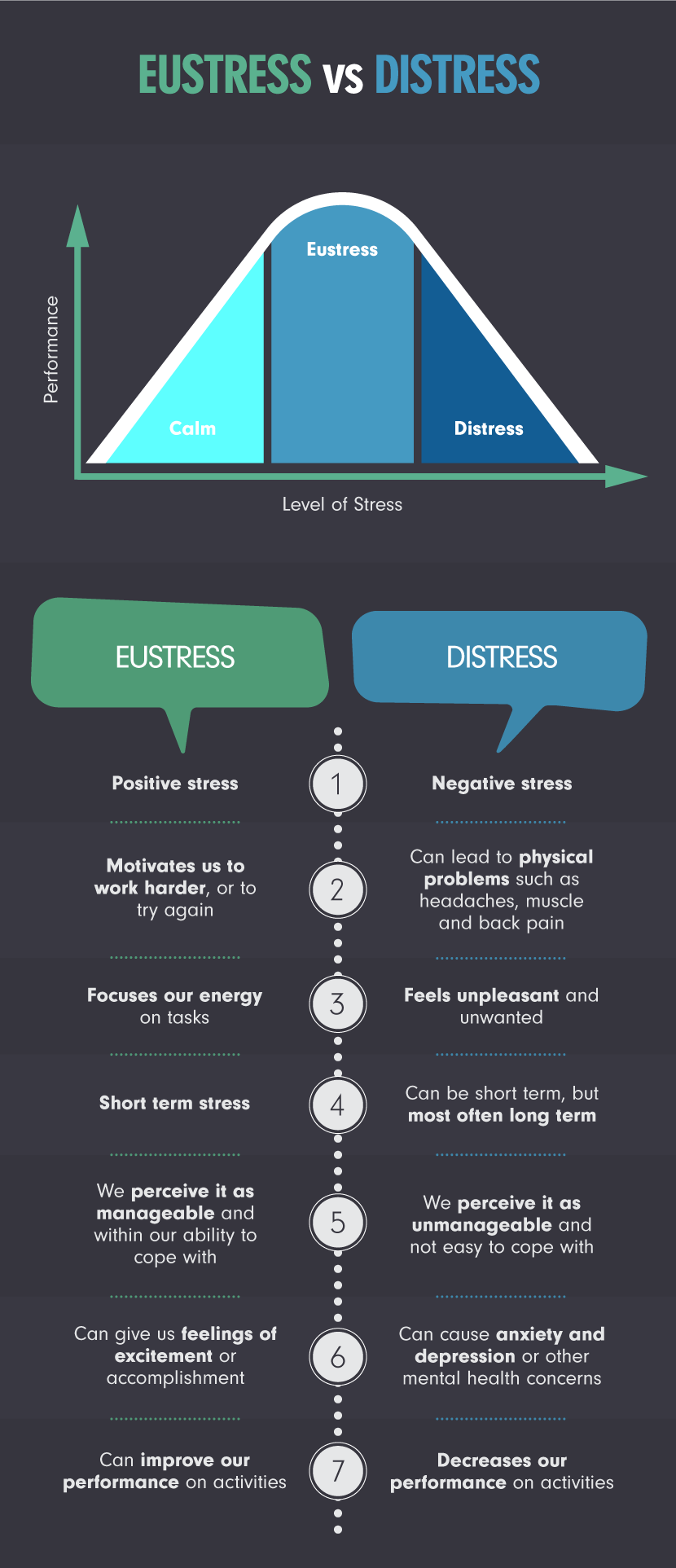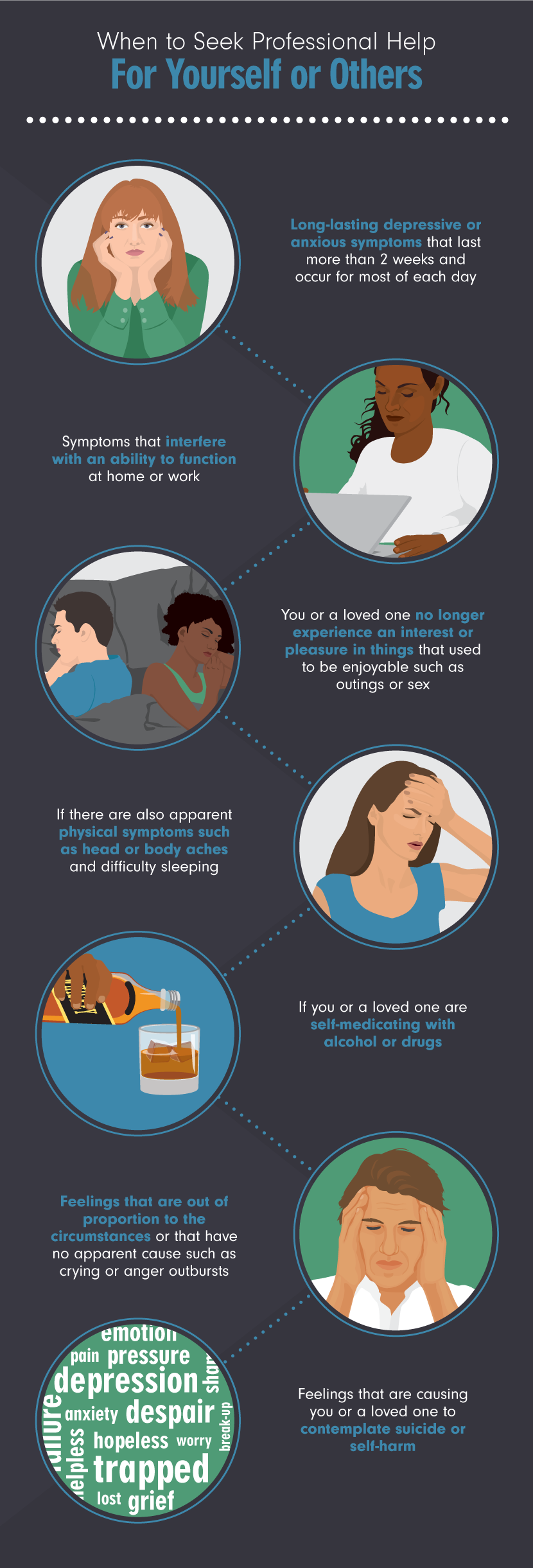Warning Signs of Declining Mental Health
Most of us will experience feelings of sadness or anxiety in our lives. Feeling down from time to time is a normal part of life because we all experience situations that make us feel negative about life: being in debt, the death of a loved one, divorce, and stress at work. When emotions that stem from a stressful situation take hold of our lives and will not go away, further support is needed. Learn the warning signs of worsening mental health, realize the differences between healthy and unhealthy stress, practice strategies to decrease stress in your daily routine, and know when to seek support from a mental health professional.
Symptoms of Anxiety and Depression
The most common mental health concerns are related to depression and anxiety. These are often experienced as complex disorders that include both mental and physical symptoms and challenges functioning in everyday life. Symptoms of depression and anxiety are often very similar and can co-occur, so it is important to learn about both conditions. Listed in the illustration below are some common symptoms of depression and anxiety:

Good Stress versus Bad Stress
Stress is not always a bad thing, and it doesn’t always lead to a diagnosis of mental health problems. Stress is your body’s response to the demands and pressures of everyday life. Sometimes stress can come in small doses that we can manage. Other times, stress can be prolonged and cause harmful effects. It is important to know the difference between good stress (eustress) and bad stress (distress) so that we can manage them appropriately.
Eustress is positive stress that gives us the energy and motivation to work harder and focus on tasks. This type of stress is short-term and most people can manage and eventually overcome it. Examples of positive stressors include:
- Starting a new job
- Getting married
- Having a child
- Buying a home
- Moving
- Retiring
- Undertaking post-secondary
These situations might very well cause some stress (debt, changes in routine, new experiences), but can also provide feelings of excitement and motivation.
Distress is stress that is unpleasant and unwanted. It can cause feelings of sadness and being overwhelmed. This type of stress is generally long-term and much harder to cope with and overcome than positive stress. Examples of negative stressors include:
- Excessive job demands and job insecurity
- The death of a loved one
- Injury to or illness of oneself or a loved one
- Being abused or neglected
- Financial problems
- Legal problems
- Conflicts in interpersonal relationships
- Unemployment
- Internal feelings and thoughts of fear, worry, and excessive expectations
These negative stressors affect our everyday lives, decrease performance, and lead to mental and physical health problems if not addressed and managed.
At one end of the spectrum, we feel calm. This is our plateau level at which we feel normal and unstressed. As events or situations happen in our lives such as the birth of a baby, signing a mortgage, etc., we may become somewhat stressed, but it typical that we return from these situations into our calm space. If events happen that are more stressful, such as divorce or the death of a loved one, we can fall further into stress and negative emotions. When we enter this distress area, it is much harder for us to re-enter our calm space.
Here are some differences between eustress (positive stress) and distress (negative stress):

How to Manage Stress Before It Becomes a Larger Problem
Learning how to manage and cope properly with stressors in your life can go a long way to maintaining your everyday health and well-being. There are ways you can incorporate stress-decreasing solutions into your everyday routine at work or home without spending too much time or money. If you have a loved one who is suffering from depression or anxiety, you can engage in these activities with them. By engaging in activities like the ones listed below, you can tackle your stress (or help others tackle theirs) before it leads to a larger mental health problem.
When to Seek Professional Help
Sometimes we can manage stress by implementing some of the strategies listed above. However, sometimes feelings of depression and anxiety are too overwhelming and debilitating for us to be active participants in our own healing. At that point, seeking professional help is a good idea. How do you know when the symptoms of depression or anxiety have reached the point where mental health support is needed? The illustration below outlines some symptoms and advice on when you should seek further support from a professional:

Stress is a part of our everyday lives and we experience it in many situations. When stress becomes unmanageable, the state of our mental health may become a concern. You can take note of the stressors in your life and work toward implementing coping strategies to handle these stressors effectively and alleviate depressive or anxious states. If you are experiencing worsening symptoms of depression or anxiety, it is important to seek external help from a professional.
Sources of Information
1. https://www.mentalhelp.net/articles/treatment-when-to-seek-professional-help-and-where- to-find-help-for-major-depression/
2. https://www.mentalhelp.net/articles/types-of-stressors-eustress-vs-distress/
